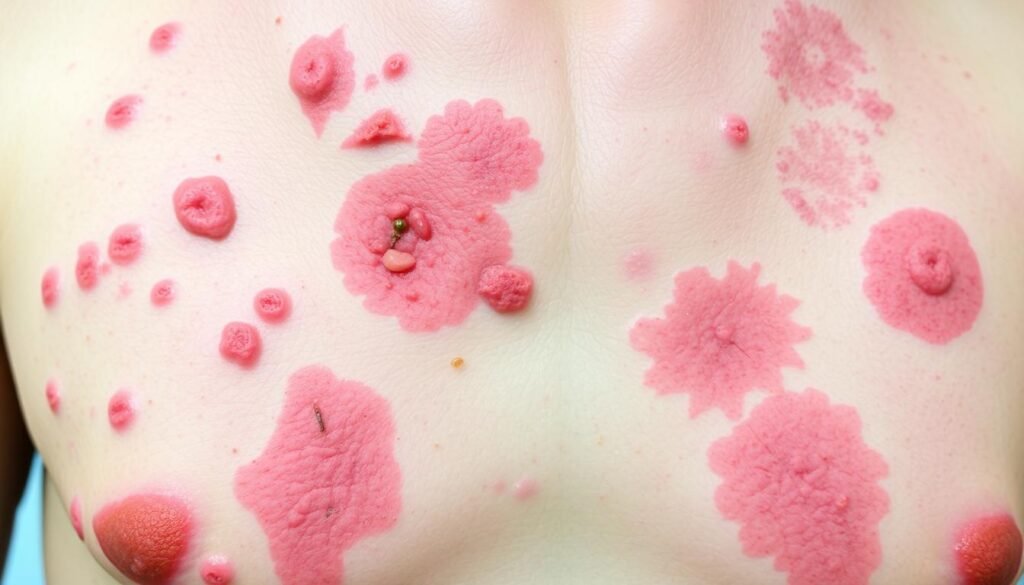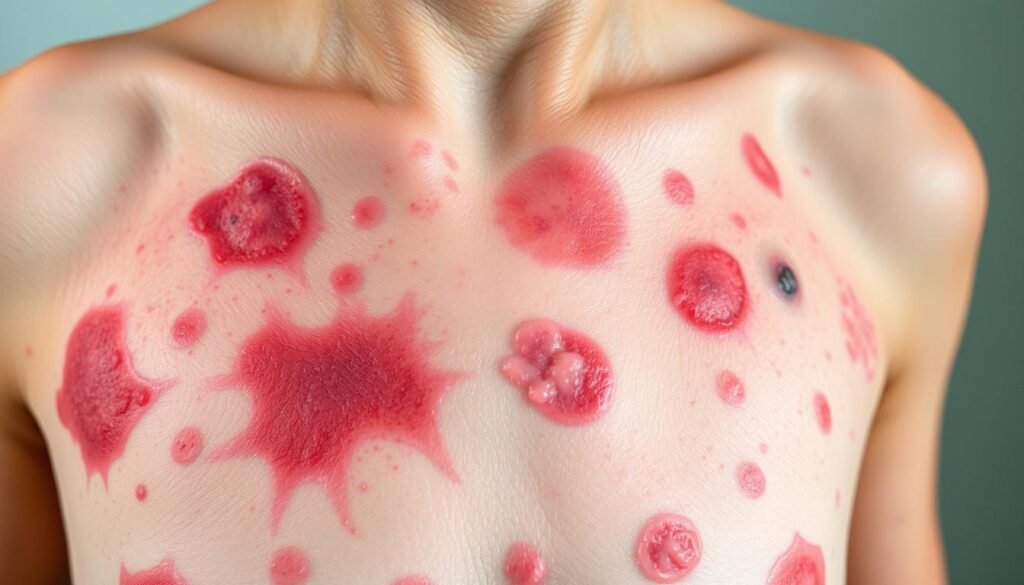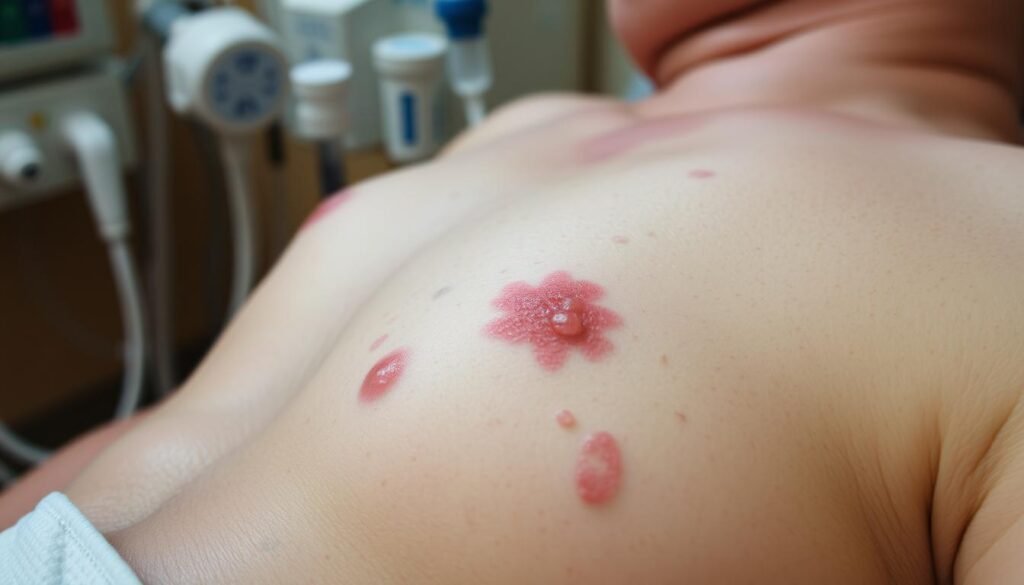Did you know about 90% of people using some EGFR inhibitors get maculopapular rashes? These treatments are for lung cancer. This fact is key for spotting skin changes, important warning signs in lung cancer care. Even though lung cancer mainly shows through breathing problems, like ongoing coughs, it can also lead to several skin symptoms. Symptoms like itchy, dry skin, easy bruising, jaundice, and even skin metastases show underlying health problems. Knowing these skin changes can really help in taking care of patients on time. Let’s explore how lung cancer affects skin health.
Key Takeaways
- Lung cancer can result in various skin changes, signaling early signs of the disease getting worse.
- Around 90% of patients taking EGFR inhibitors report getting skin rashes.
- These skin symptoms often appear with other lung cancer signs, like continuous coughing.
- Watching skin changes closely can tell a lot about a patient’s health status.
- Talking to a doctor about major skin changes is vital for prompt action.
Understanding Lung Cancer and Its Symptoms
Lung cancer may not show signs early on. People often miss symptoms until the disease is advanced. One common sign is a continuous cough, which gets worse over time. Sufferers may also feel chest pain when they breathe deeply or cough.
Coughing up blood is a serious symptom that needs quick medical help. As the disease gets worse, shortness of breath makes daily life hard. Weight loss without trying is also a common sign. It can point to a serious health issue.
Spotting these signs early is crucial for doctors. It helps them start treatment soon. This can make the treatments work better, offering a brighter outlook for patients.
The Connection Between Lung Cancer and Skin Symptoms
Skin changes can hint at lung cancer. These signs are getting more attention from doctors. For instance, a skin rash in a patient showed lung cancer had returned. This points out how skin symptoms may be early lung cancer warnings.
In a real story, a rash was the first hint of lung cancer coming back. This shows why it’s key to see a doctor for weird skin changes. The goal is to catch lung cancer signs early.
Sometimes, lung cancer causes specific skin changes. This happens because of how our bodies react to cancer. Figuring out these signs quickly can help start treatment sooner. This could lead to better results for patients. If you’re worried about lung cancer affecting your skin, knowing these signs is important.
Doctors say to watch your skin closely. Tell your doctor about any big changes. Paying attention can help spot lung cancer signs early. This can make treatments work better.
Knowing how skin symptoms and lung cancer are linked is crucial. For more about lung cancer signs and skin changes, check out this guide. It’s full of helpful information.
Lung Cancer Rash: Recognizing the Signs
Spotting a lung cancer rash is key for early detection. The skin often shows the first signs of internal diseases like lung cancer. It’s vital to know these signs and their connection to lung cancer.
Common Skin Changes Associated with Lung Cancer
Various skin issues can signal lung cancer. These symptoms include:
- Dryness and itchiness
- Red or purple bumps known as metastatic skin nodules
- Skin discoloration, especially yellowing or patches
- Rashes of different textures
Knowing these signs helps spot possible problems. It stresses the importance of regular skin checks.
Non-Cancerous Skin Changes vs. Lung Cancer Rash
It’s crucial to tell non-cancerous and cancerous skin changes apart. Many conditions, like allergies or infections, can mimic a lung cancer rash. To tell them apart, look for:
| Feature | Non-Cancerous Skin Changes | Lung Cancer Rash |
|---|---|---|
| Appearance | Often irregular and typically resolves with treatment | Firm nodules that persist or worsen |
| Itching | Variable severity, often manageable | More intense, suggesting deeper issues |
| Healing Time | Usually heals quickly with care | May not improve, leading to complications |
By keeping an eye on these skin conditions, you can get help faster. This step can make a big difference in lung cancer care and outcomes.
Cutaneous Manifestations of Lung Cancer
Skin symptoms can tell us a lot about lung cancer. They vary in how they look. Spotting these skin signs helps track lung cancer’s spread. An early response to skin changes can greatly improve treatment success.
Types of Skin Lesions Linked to Lung Cancer
Different skin lesions can point to lung cancer. Some of them are:
- Metastatic nodules: These look like firm, raised bumps.
- Plaques: These are elevated patches with different colors and textures.
- Palpable purpura: This is bruising that suggests bleeding under the skin.
Studies show 1-12% of tumors can lead to skin spreading. Non-small-cell lung cancer especially tends to show this. Adenocarcinoma, in particular, is often linked to skin metastasis. This shows how varied skin signs in lung cancer can be.
Importance of Monitoring Skin Changes
Watching for skin changes is critical for lung cancer patients. New or changing lesions are serious. They could mean the cancer is growing. About 2–8% of lung cancer patients will see skin spread. In some cases, the skin is the first spot cancer shows up, in about 25% of situations. Those with skin involvement face lower survival chances. This underscores the importance of regular skin checks.

Talking with doctors about skin changes is key. Knowing about different lesions helps patients seek help faster. This can lead to better health management.
| Type of Skin Lesion | Characteristics | Associated Lung Cancer Type |
|---|---|---|
| Metastatic Nodules | Firm, raised bumps | Non-small-cell lung carcinoma |
| Plaques | Elevated patches, varying color | Adenocarcinoma |
| Palpable Purpura | Bruises due to bleeding under the skin | Small-cell lung carcinoma |
Paraneoplastic Syndromes Related to Lung Cancer
Paraneoplastic syndromes are rare conditions linked to lung cancer. They result from the body’s immune response to the tumor, not directly from the cancer. Understanding these conditions helps us grasp the complexity of lung cancer and its effects on health.
Understanding Paraneoplastic Syndromes
About 10% of people with lung cancer face paraneoplastic syndromes. These can lead to skin issues and other widespread symptoms. They occur when the tumor releases certain hormones or proteins, or through an autoimmune response. Recognizing these symptoms early is vital for improving life quality.
Types of Paraneoplastic Syndromes Associated with Lung Cancer
Several paraneoplastic syndromes are directly tied to lung cancer, including:
- Cushing’s syndrome: Often seen with small cell lung cancer (SCLC), it arises from ectopic hormone secretion by cancer cells. It leads to specific health issues like hypokalemic metabolic alkalosis and high blood pressure.
- Hypercalcemia: At the time of diagnosis, 2–6% of patients face this, with rates increasing during the disease. Squamous cell carcinoma sees up to a 23% occurrence rate.
- Syndrome of inappropriate ADH secretion (SIADH): Affecting 10–45% of small cell lung cancer cases, it causes fluid imbalance and low sodium levels.
- Acromegaly: This condition can arise from abnormal hormone secretion, often connected with bronchial carcinoids in lung cancer patients.
- Anti-Hu syndrome: Characterized by anti-Hu antibodies in about 90% of SCLC cases, it triggers various neurological issues, including limbic encephalitis.
These syndromes show the complex link between lung cancer and various symptoms. Ongoing checks and clinical evaluations are important for those diagnosed with lung cancer.
Identifying Specific Skin Rashes Related to Lung Cancer
Identifying certain skin rashes is crucial when looking for signs of lung cancer. Erythema gyratum repens and dermatomyositis are key conditions that need attention. These conditions show unique signs that help doctors in their diagnosis.
Erythema Gyratum Repens
Erythema gyratum repens is a skin rash that could mean an underlying cancer, including lung cancer. It shows up as rings or waves on the skin. When this rash appears, it’s important to check further because it might signal serious health issues.
Dermatomyositis and Its Implications
Dermatomyositis is important to know about when considering lung cancer. It includes a rash, often near the eyes, and muscle weakness. This condition suggests the need for detailed checks because it could point to hidden cancers.

Skin Metastases: When Lung Cancer Spreads to the Skin
Skin metastases are a serious sign in those with lung cancer. This occurs when cancer from the lungs moves to the skin. It’s vital to know about these metastases, how they look, and where they often appear.
Appearance and Characteristics of Skin Metastases
Skin metastases usually look like round, hard nodules or sores. They can be as small as 2 mm to 6 cm across. Different lung cancers affect how skin metastases look. The most common ones to spread are adenocarcinomas, squamous-cell carcinomas, small-cell carcinomas, and large-cell carcinomas. They mainly show up on the head, neck, chest, and belly.
Frequency and Locations of Skin Metastases
Between 1% and 12% of people with lung cancer will have skin metastases. Men are more likely to get them first. Around 25% find out about their lung cancer after noticing skin lesions. Lung cancer spreads to the skin fast, usually in about 5.75 months. This shows how important it is to watch for skin changes.
For more info on lung cancer and skin metastases, check out this study. Staying alert to these signs helps manage the spread of lung cancer.
Impact of Lung Cancer Treatment on Skin Health
Lung cancer treatment impacts skin health in many ways. Patients might face issues from mild irritation to more severe conditions. Knowing about these side effects helps patients take care of their skin during treatment.
Side Effects of Radiation Therapy on the Skin
Radiation therapy can cause several radiation therapy side effects on the skin. Here are common ones:
- Redness and inflammation, like sunburn
- Peeling skin
- Itching and discomfort
The severity of these symptoms can vary. Medical teams often suggest moisturizers and protective gear to ease discomfort. Knowing about these effects helps in managing skin health better.
Effects of Chemotherapy on Skin Conditions
Chemotherapy often leads to skin issues. Up to 95% of patients taking Epidermal Growth Factor Receptor inhibitors see skin problems, like rashes and acne. Other side effects include:
- Skin dryness and peeling
- Increased sensitivity
- Hair loss, affecting roughly 26% of chemotherapy patients
These issues are more than cosmetic, leading to infections and discomfort. Talking to healthcare providers early is crucial. Using the right products and keeping skin moist helps a lot. Support becomes crucial, as options like addressing skin reactions help patients through their journey.

| Common Skin Reactions | Possible Management Strategies |
|---|---|
| Redness | Use gentle moisturizers and avoid irritants |
| Peeling Skin | Keep skin moisturized and consult healthcare providers for recommendations |
| Itching | Use anti-itch creams and maintain hydration |
| Hair Loss | Wigs or scarves for comfort and self-esteem |
| Rashes | Monitor symptoms closely; seek medical advice for severe cases |
Understanding skin health effects from lung cancer treatment encourages a proactive stance. Keeping in touch with healthcare teams helps manage side effects well. This support promotes wellness throughout treatment.
Understanding Common Skin Symptoms in Lung Cancer Patients
Lung cancer patients may face skin issues due to the disease or treatments. You’ll learn about itchy skin and easy bruising here. These problems can really affect their daily lives.
Itchy Skin and Its Causes in Lung Cancer Patients
Itchy skin is common in lung cancer patients. It’s often caused by treatments like chemotherapy and radiation. These can make skin dry and irritated. Also, certain meds, like EGFR inhibitors, might cause acne-like rashes and itchiness.
It’s crucial for patients to watch these signs. They could signal serious issues, such as liver problems.
Easy Bruising and Changes in Skin Texture
Patients also often bruise easily. This is because treatments like chemotherapy can lower blood platelet counts. Such changes make the skin more fragile and prone to bruising.
This condition can also raise the risk of skin inflammation. Knowing about these changes helps patients manage their symptoms better.
Dealing with these skin issues through good skincare and talking to doctors is key. For more info on managing lung cancer symptoms, here’s a comprehensive resource. It covers how to recognize symptoms and take proactive steps.
Precautions and Management of Skin Symptoms in Lung Cancer
Keeping skin healthy is crucial when treating lung cancer. It enhances comfort and life quality. Various skin issues can arise, needing careful attention and treatment strategies.
A good skincare routine can significantly ease these symptoms.
Skin Care Tips During Treatment
For healthy skin, follow several important steps. Here’s what patients should do:
- Avoid known irritants including harsh soaps and fragrances.
- Utilize hydrating moisturizers regularly to keep the skin hydrated.
- Wear protective clothing and use sunscreen to shield the skin from sun exposure, particularly given the increased sensitivity from certain treatments.
- Gently cleanse the skin without scrubbing to prevent further irritation.
- Keep the skin clean and dry, especially in skin folds, to minimize the risk of infections.
When to Consult a Dermatologist
Be on the lookout for ongoing or severe skin issues. It’s smart to see a dermatologist in these situations:
- If rashes or skin changes do not improve with at-home treatments after a few days.
- For any signs of infection such as increased redness, warmth, or pus.
- If skin symptoms significantly impact daily life and emotional well-being.
- To discuss potential treatments specifically tailored to skin issues arising from lung cancer therapies.
| Skin Issue | When to Consult a Dermatologist |
|---|---|
| Persistent Rashes | If lasting more than a few days without improvement |
| Signs of Infection | Increased redness, warmth, or pus |
| Emotional Impact | If symptoms affect daily life significantly |
| Specific Skin Treatments | To discuss options tailored to lung cancer therapy |
Other Potential Skin Conditions to Monitor
It’s key for lung cancer patients to keep an eye on different skin conditions. These issues might show there are deeper problems or new things happening. One important condition to watch is pityriasis rubra pilaris because it can be linked with cancer growth.
Pityriasis Rubra Pilaris as a Symptom
Pityriasis rubra pilaris stands out with its red, scaly skin patches. These patches can spread over big areas. When this condition appears, it could be hinting at lung cancer. So, it’s crucial for patients to talk about any skin changes with their doctors for the best care.
How Other Skin Conditions May Signal Lung Cancer
Apart from pityriasis rubra pilaris, there are other skin issues lung cancer patients should watch. Actinic keratosis and squamous cell carcinoma are two such conditions. They show up as scaly patches or pink spots that might bleed. Recognizing these signs is important. It helps patients and doctors check for possible lung cancer connections early.
Importance of Communication with Healthcare Providers
Lung cancer poses a big health challenge and needs quick, effective care. It’s important for patients to talk openly with their healthcare team. This helps in getting holistic care. Patients can share their worries about skin changes, side effects of treatment, and their overall health through these talks.
Good communication is key for keeping track of lung cancer. It makes patients feel like they’re not alone in their fight. Feeling supported is crucial during treatment.
Patients want to understand and control their treatment options. Being part of their care discussions helps them follow their treatment better. Healthcare providers learn what patients prefer and fear. This improves care quality.
A strong bond between patients and their care team deeply affects treatment. Empathetic talks help understand each patient’s unique needs and worries. Listening leads to smarter choices about treatments, like whether to choose chemotherapy or surgery. Companies making medicines also tailor their marketing to fit what patients need better.
Many lung cancer patients find out about their illness too late. This makes clear, kind talks even more important. These discussions can help catch problems sooner, which can make treatments work better. Patients can also share if they’re struggling with mental or physical issues, like skin problems, affecting their life.
| Aspect | Impact on Patient Care |
|---|---|
| Clear Communication | Better treatment adherence |
| Empathy | Positive treatment experiences |
| Patient Involvement | Enhanced quality of life |
| Responsive Feedback | Timely interventions |
For lung cancer patients, talking well with their healthcare team is vital. Keeping up this dialogue supports and empowers them. It fosters a team approach that can lead to better health outcomes.
Conclusion
It’s vital to understand how lung cancer and skin symptoms are connected. This knowledge can help catch the disease early. By paying attention to skin health changes, both patients and doctors can make a big difference in care. Research, including 33 studies with 6,798 people, shows skin symptoms link to better health results.
Patients with skin rashes from lung cancer tend to do better. They show higher rates of response to treatment and control over the disease. A rash often means longer survival times without the disease getting worse, and overall longer life. So, spotting these signs early can guide better treatment plans.
Some skin conditions hint at lung cancer coming back. For example, pityriasis rubra pilaris is one such indicator. This shows why keeping an eye on lung health is crucial for everyone involved. Talking openly about any skin changes helps improve life quality for people fighting cancer. It makes a huge difference in their battle.